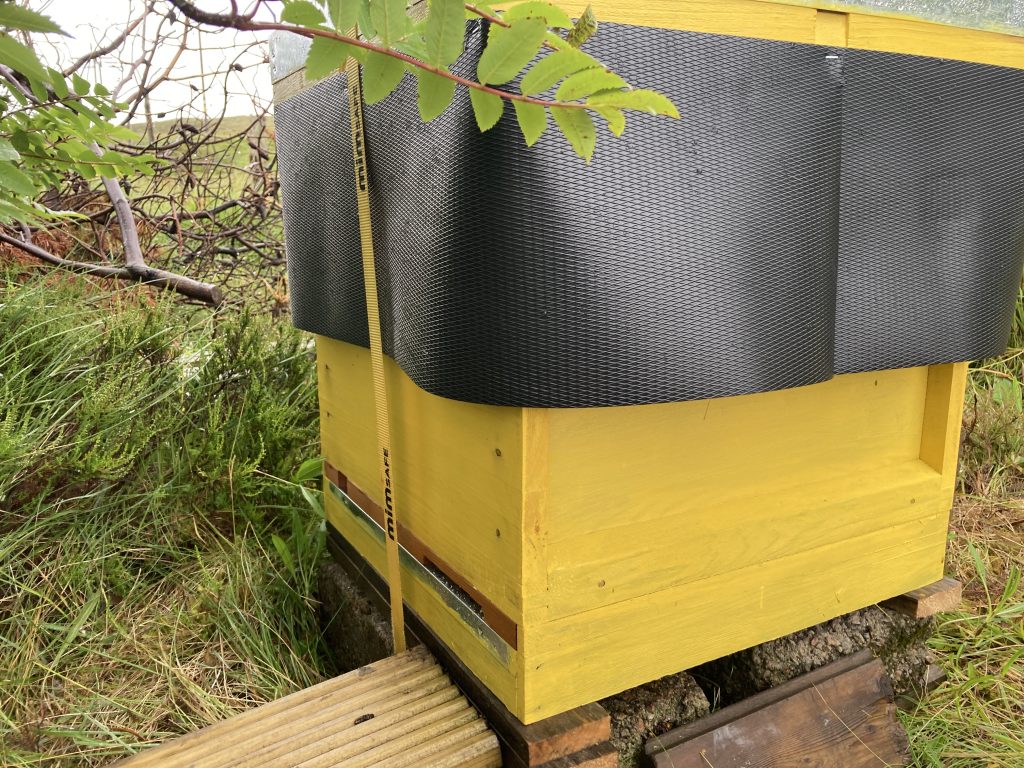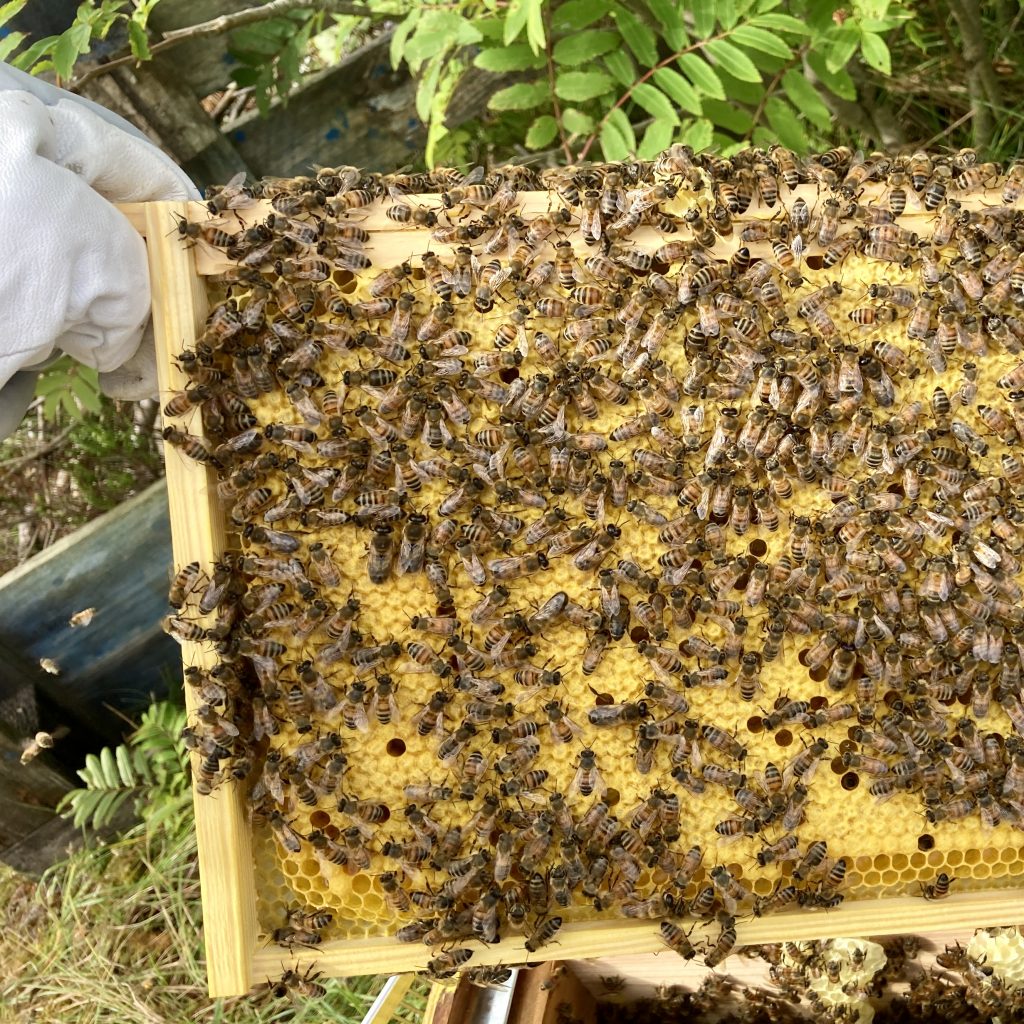To Super, or not to Super, that is July…
As we entered July the rainfall was still fallin’, the breeze still breezin’ and the temperature still, erm, cool. So much so that by the 4th July I was concerned about the amount of rain that appeared to have been driven into the hive. More about that, and my solution, later.
I noted at the start of the month the bees were taking down the 1:1 syrup I had provided at a rapid rate of around 500ml a day. This, along with the constant influx of pollen from foraging bees, could only be a good sign. Despite the near endless rain (very heavy at times) the bees were getting out at every break they could and returning fully laden with a multitude of orange, yellow, red and white coloured pollen.
The rain was becoming a concern, so I continued to feed them sugar syrup to supplement the lack of foraging hours as the nucleus continued to expand. I was worried about the driving rain in particular as that seemed to be entering the hive, causing a build up of water on the crown board (directly above the bees) and inside the walls. I doubt this would be an issue normally as between the rain spells the hive would breath and dry out. However no dry or warm spell was in sight.
The Bee Kilt
I needed to extend the hive lid to prevent water driving up and under the rim. I didn’t want to remove the lid for any length of time because of the weather, and so the usual method of gluing on wooden extensions was not really an option. The cooler nights were worrying me; bees can cope perfectly fine with cold weather, but not inside a wet hive.
The answer?
Damp Proof (of) Course! DPC is waterproof, tough, flexible, and could be stapled into position without disturbing the hive by removing the lid. So whilst it was raining (yes, still raining) I promptly stapled an 8″ roll of DPC around the lid to produce a skirt. Or as they call them in Scotland, a kilt.
As you can see from the photograph, this drop not only extended the lid but also covered the next join between boxes. Yes, it doesn’t look great, and is certainly not conventional, but it appears to be doing the job, for now at least!

What a Difference Six Days Makes
This months inspections have been a tale of two halves. As mentioned, the start of the month it was wet but the bees were making steady enough progress, or at least heading in the right direction. There was an increase in brood cells totalling about five frames. The queen was observed, close to the top of the frame again so clearly not shy. But given the weather and the fact that they had only just started to draw out one of the five new frames I made a note in my diary to perhaps skip the following inspection and just let them get on in peace. It is generally accepted that 4-6 weeks is when a new nucleus of bees really starts to expand, and at this point we were only at the third inspection.
144 little hours, brings the sun and the flowers!
Six days later the sky was blue, a near-record high temperature for the island was recorded, and the bees were in bloom. Scrub the diary note, the next inspection was definitely on!
There were almost twice the number of brood compared to a week ago, all but one of the new frames had been drawn out as comb, and two frames were full of nectar. I am so glad I hadn’t skipped this inspection.
A decision had to be made regarding space for the bees. Too much and they’ll have to work harder to keep is cosy, to little and the queen might be restricted in her laying which could cause grumpy bees or even a swarm as they look for somewhere new to call home. If they could book a ferry at this very busy time of year they’d probably head for somewhere sunnier and drier, and who could blame them!
As the nectar was flowing and the queen laying freely I took off the 1:1 syrup feeder and added a super of foundation (an empty frame of wax ready for them to turn into comb and begin filling with stores of honey). The queen excluder was put in (to keep the queen in the brood box below) and the cover put back on. Realistically they may have been ok until the next weekly inspection, but I wasn’t sure. Given the temperature, the flow of nectar coming in, and the rate the queen was laying I decided this was the best call. I was also keen to let them make the most of drawing out new frames whilst they were on a roll, and given the 21 day development of a worker bee, around 5000 new bees should be emerging before the next inspection, and a further 20-40,000 before next month.

Another week passed, the weather varied from warm to wet, and the bees continued to work hard at bringing in stores, laying new brood, and drawing out comb in the super. By the end of the month the brood box was full and the super was drawn out to four frames of nectar. Beekeeping is a balancing act. This month I am torn between giving the queen more room to lay (as I am sure she is up to it) or holding on a few more weeks to see what the weather and nectar flow does. It’s likely I’ll take out a few frames of nectar and add a couple of new frames to the brood box, to see if she utilises the space. It would be beneficial for next spring to have as much drawn out comb as possible for dividing the colony and expanding my hives.
Varroa Mite Checks
I carried out a varroa mite check using two methods. Other methods are available but usually involve sacrificing bees.
The first was adding a mite board below the mesh floor of the hive. This collects any mites dropped as the bees groom themselves, and can be counted to give a calculation of the total mites present in the colony. In this instance no mites showed on the board.
The second method was a visual inspection of the bees, where I deliberately and closely inspected them for signs of mites (including photographing each frame of bees and analysing later on a computer). I also checked inside of capped brood that had to be destroyed when removing the queen excluder (inevitably there will always be a few losses during hive inspections). Again, no signs of mites within the capped brood cells or the uncapped eggs and larvae. So far so good as far as having no varroa mites goes. I shall continue to monitor and make a decision about treating next month. Not treating over winter presents a high risk to the colony should mites get hold, however a common issue livestock owners face in balancing the need for treatment against the risks of resistance to treatments.

What was (or wasn’t) present this month:
- The Queen – a regular show off and not shy at all.
- Brood in all stages eggs, larvae, and capped brood
- No queen cells (just a few play cups)
- No varroa mites
- Stores of nectar
- A full box of drawn out brood frames
- Four frames of new comb drawn in the super
- Lots more bees again!
All of the bees looked healthy and still on task.
Learning Points for July
So what did July show us?
- Bees (still) know what they are doing!
- This queen is a hugely prolific layer.
- Ask the right beekeeper the right questions and you’ll get a right answers.
- Beekeeping is (still) as awesome as I hoped it would be!
- When the bees get the chance they REALLY get going at a surprising rate!
- It’s a kilt, not a skirt…

Leave a Reply